Leadership Theories and My Leadership Style: A Reflective Blog Post
VerifiedAdded on 2023/01/18
|19
|2218
|37
Homework Assignment
AI Summary
This blog post delves into the multifaceted world of leadership, exploring various theories and their practical applications. The author begins by defining leadership as a critical organizational pillar, emphasizing the leader's role in influencing and motivating employees to achieve organizational goals. The post then examines key leadership theories, including participative and contingency models, highlighting their strengths and weaknesses. Further exploration covers transformational, behavioral, and trait theories, providing a comprehensive overview of different leadership styles. The author reflects on their personal leadership style, expressing a preference for participatory and transformational approaches. They articulate a commitment to empowering their team and fostering active involvement in organizational affairs. The post concludes with a reflection on the knowledge gained and its potential to shape their leadership journey. The post includes images and references and also provides comments on classmate posts.
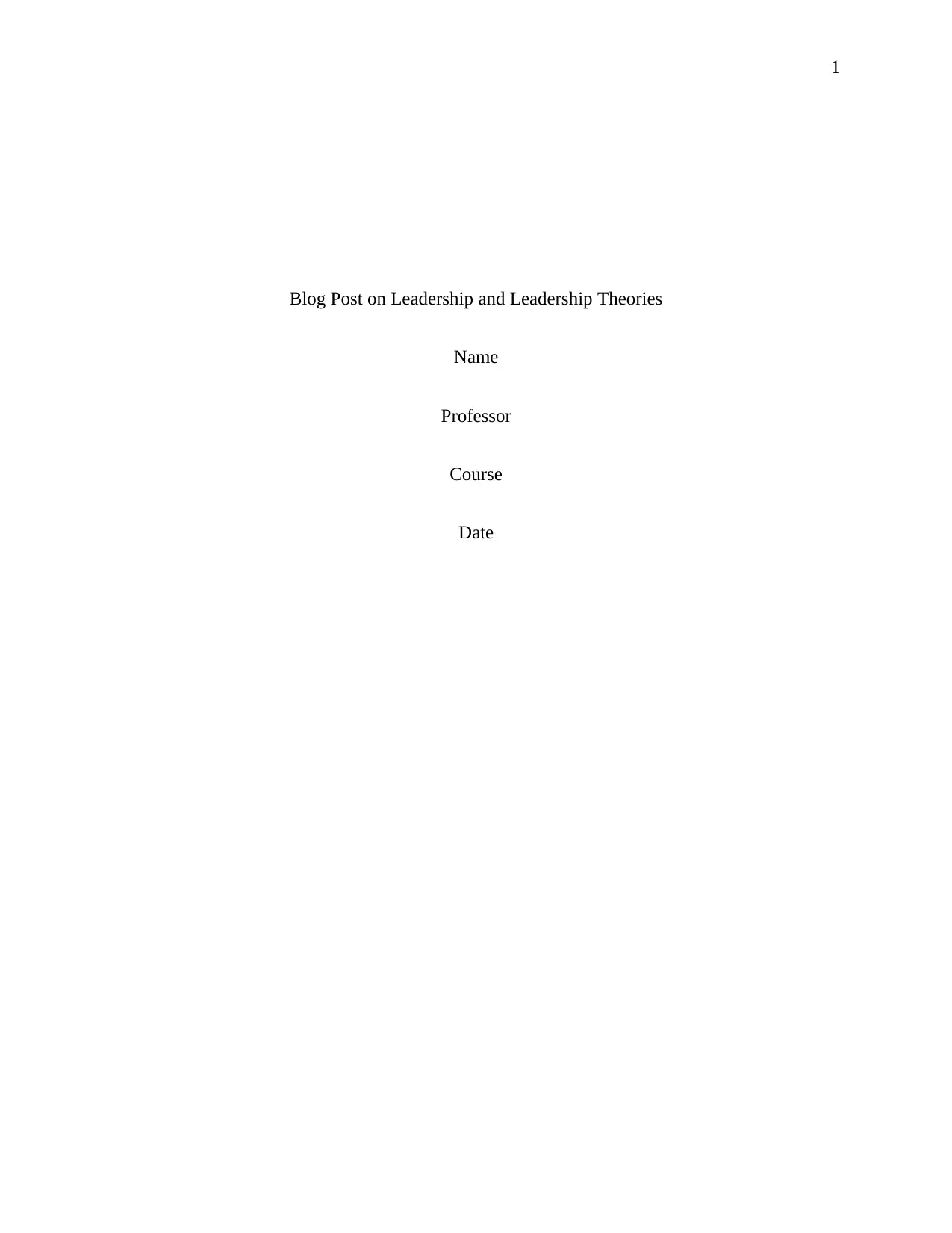
1
Blog Post on Leadership and Leadership Theories
Name
Professor
Course
Date
Blog Post on Leadership and Leadership Theories
Name
Professor
Course
Date
Paraphrase This Document
Need a fresh take? Get an instant paraphrase of this document with our AI Paraphraser
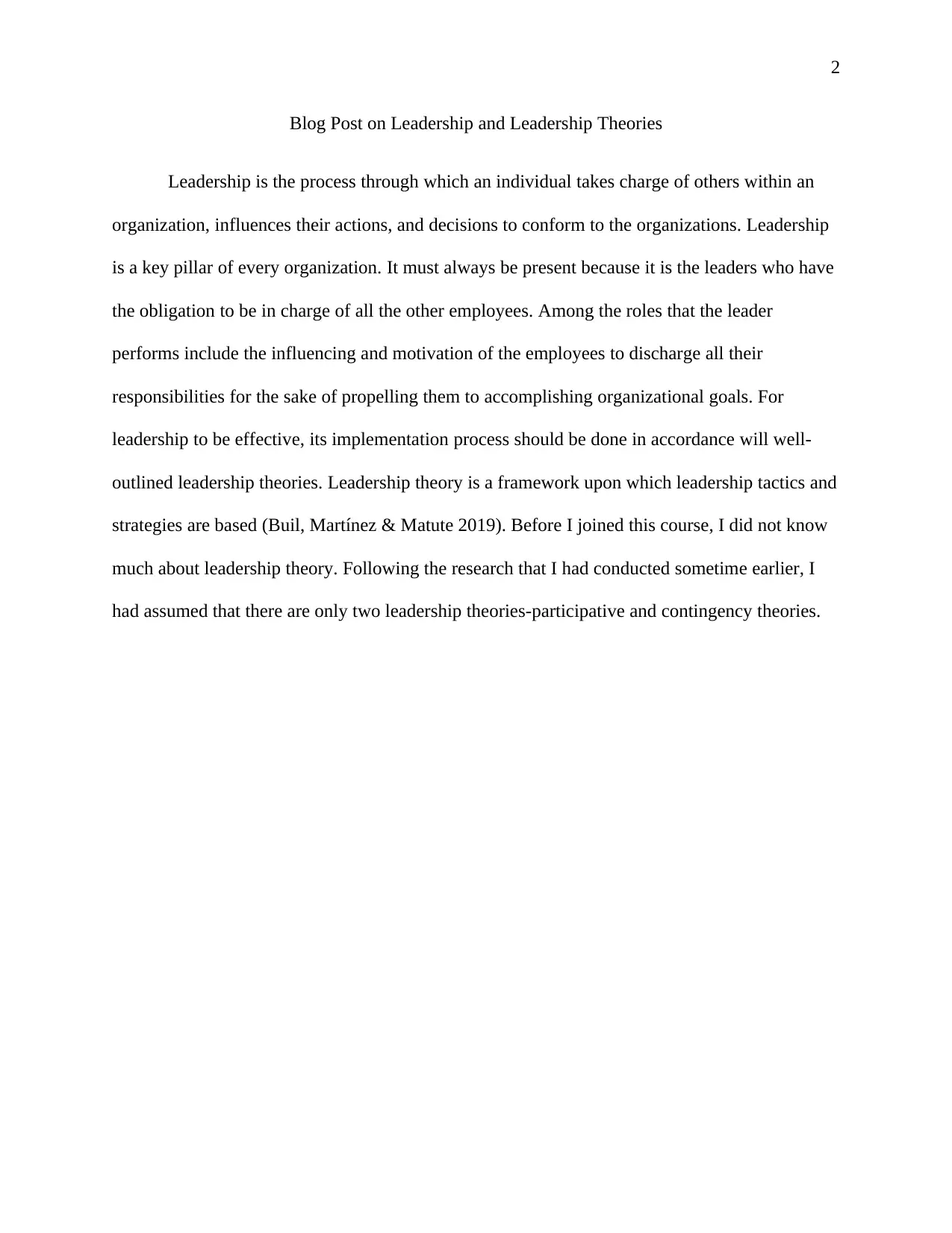
2
Blog Post on Leadership and Leadership Theories
Leadership is the process through which an individual takes charge of others within an
organization, influences their actions, and decisions to conform to the organizations. Leadership
is a key pillar of every organization. It must always be present because it is the leaders who have
the obligation to be in charge of all the other employees. Among the roles that the leader
performs include the influencing and motivation of the employees to discharge all their
responsibilities for the sake of propelling them to accomplishing organizational goals. For
leadership to be effective, its implementation process should be done in accordance will well-
outlined leadership theories. Leadership theory is a framework upon which leadership tactics and
strategies are based (Buil, Martínez & Matute 2019). Before I joined this course, I did not know
much about leadership theory. Following the research that I had conducted sometime earlier, I
had assumed that there are only two leadership theories-participative and contingency theories.
Blog Post on Leadership and Leadership Theories
Leadership is the process through which an individual takes charge of others within an
organization, influences their actions, and decisions to conform to the organizations. Leadership
is a key pillar of every organization. It must always be present because it is the leaders who have
the obligation to be in charge of all the other employees. Among the roles that the leader
performs include the influencing and motivation of the employees to discharge all their
responsibilities for the sake of propelling them to accomplishing organizational goals. For
leadership to be effective, its implementation process should be done in accordance will well-
outlined leadership theories. Leadership theory is a framework upon which leadership tactics and
strategies are based (Buil, Martínez & Matute 2019). Before I joined this course, I did not know
much about leadership theory. Following the research that I had conducted sometime earlier, I
had assumed that there are only two leadership theories-participative and contingency theories.
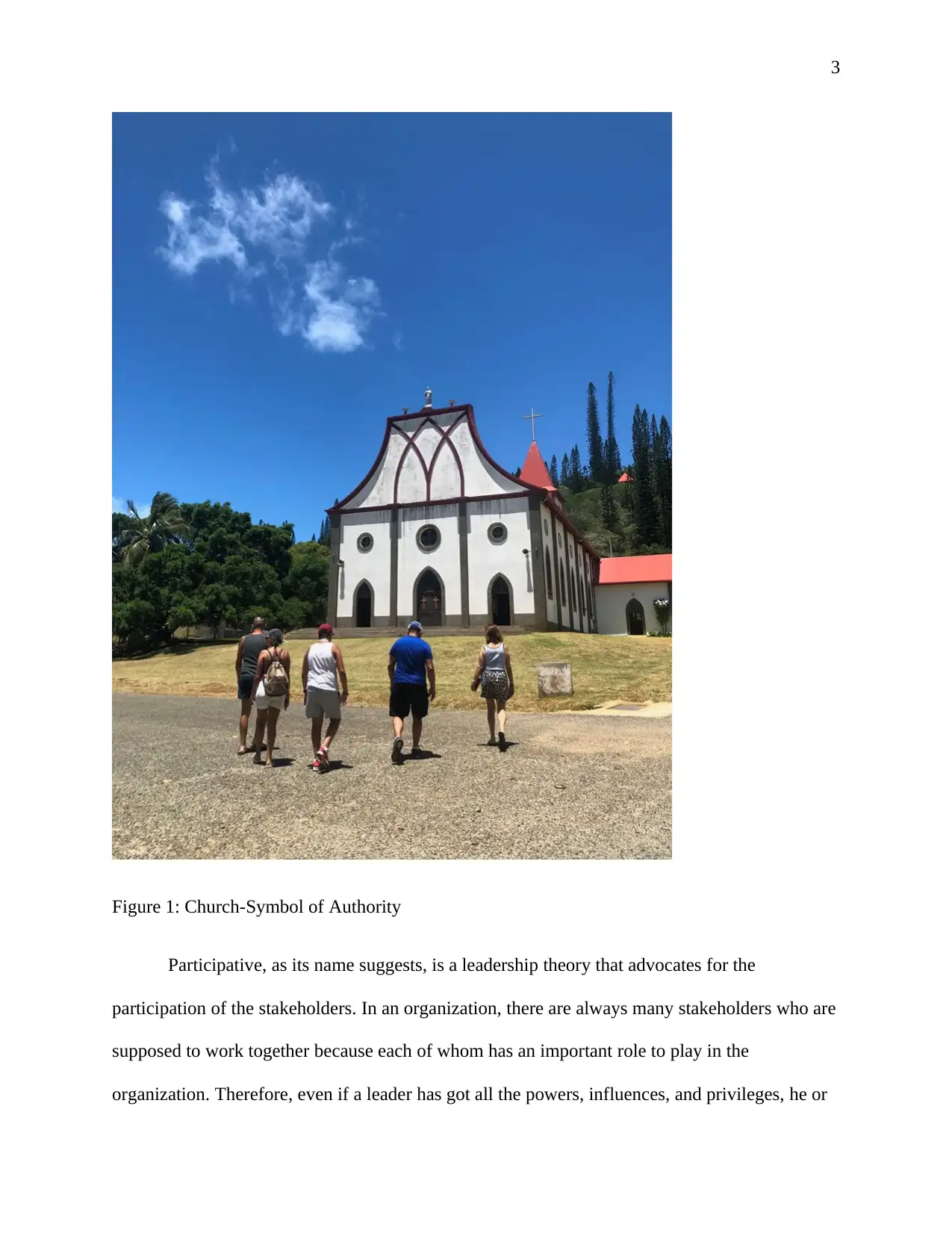
3
Figure 1: Church-Symbol of Authority
Participative, as its name suggests, is a leadership theory that advocates for the
participation of the stakeholders. In an organization, there are always many stakeholders who are
supposed to work together because each of whom has an important role to play in the
organization. Therefore, even if a leader has got all the powers, influences, and privileges, he or
Figure 1: Church-Symbol of Authority
Participative, as its name suggests, is a leadership theory that advocates for the
participation of the stakeholders. In an organization, there are always many stakeholders who are
supposed to work together because each of whom has an important role to play in the
organization. Therefore, even if a leader has got all the powers, influences, and privileges, he or
⊘ This is a preview!⊘
Do you want full access?
Subscribe today to unlock all pages.

Trusted by 1+ million students worldwide
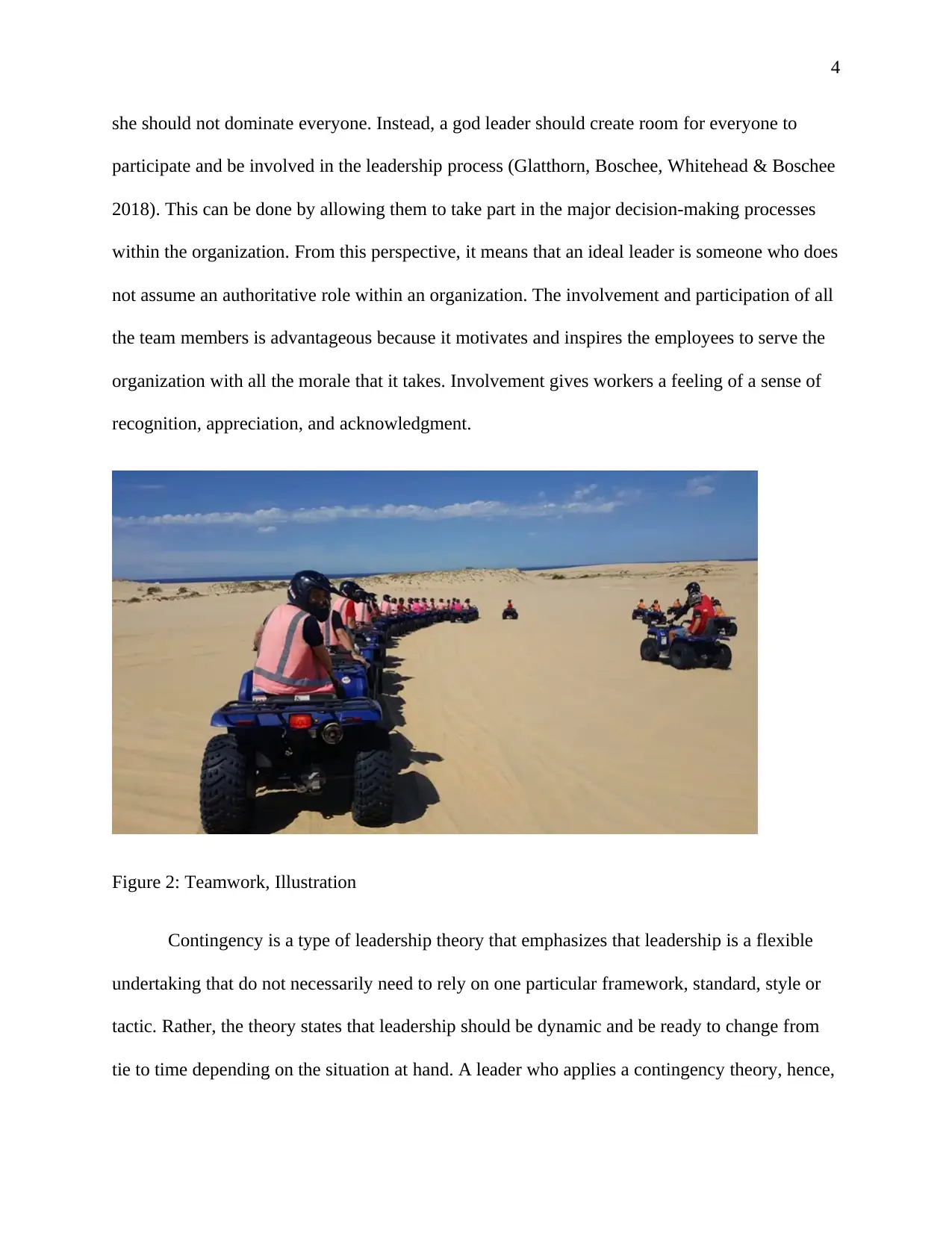
4
she should not dominate everyone. Instead, a god leader should create room for everyone to
participate and be involved in the leadership process (Glatthorn, Boschee, Whitehead & Boschee
2018). This can be done by allowing them to take part in the major decision-making processes
within the organization. From this perspective, it means that an ideal leader is someone who does
not assume an authoritative role within an organization. The involvement and participation of all
the team members is advantageous because it motivates and inspires the employees to serve the
organization with all the morale that it takes. Involvement gives workers a feeling of a sense of
recognition, appreciation, and acknowledgment.
Figure 2: Teamwork, Illustration
Contingency is a type of leadership theory that emphasizes that leadership is a flexible
undertaking that do not necessarily need to rely on one particular framework, standard, style or
tactic. Rather, the theory states that leadership should be dynamic and be ready to change from
tie to time depending on the situation at hand. A leader who applies a contingency theory, hence,
she should not dominate everyone. Instead, a god leader should create room for everyone to
participate and be involved in the leadership process (Glatthorn, Boschee, Whitehead & Boschee
2018). This can be done by allowing them to take part in the major decision-making processes
within the organization. From this perspective, it means that an ideal leader is someone who does
not assume an authoritative role within an organization. The involvement and participation of all
the team members is advantageous because it motivates and inspires the employees to serve the
organization with all the morale that it takes. Involvement gives workers a feeling of a sense of
recognition, appreciation, and acknowledgment.
Figure 2: Teamwork, Illustration
Contingency is a type of leadership theory that emphasizes that leadership is a flexible
undertaking that do not necessarily need to rely on one particular framework, standard, style or
tactic. Rather, the theory states that leadership should be dynamic and be ready to change from
tie to time depending on the situation at hand. A leader who applies a contingency theory, hence,
Paraphrase This Document
Need a fresh take? Get an instant paraphrase of this document with our AI Paraphraser
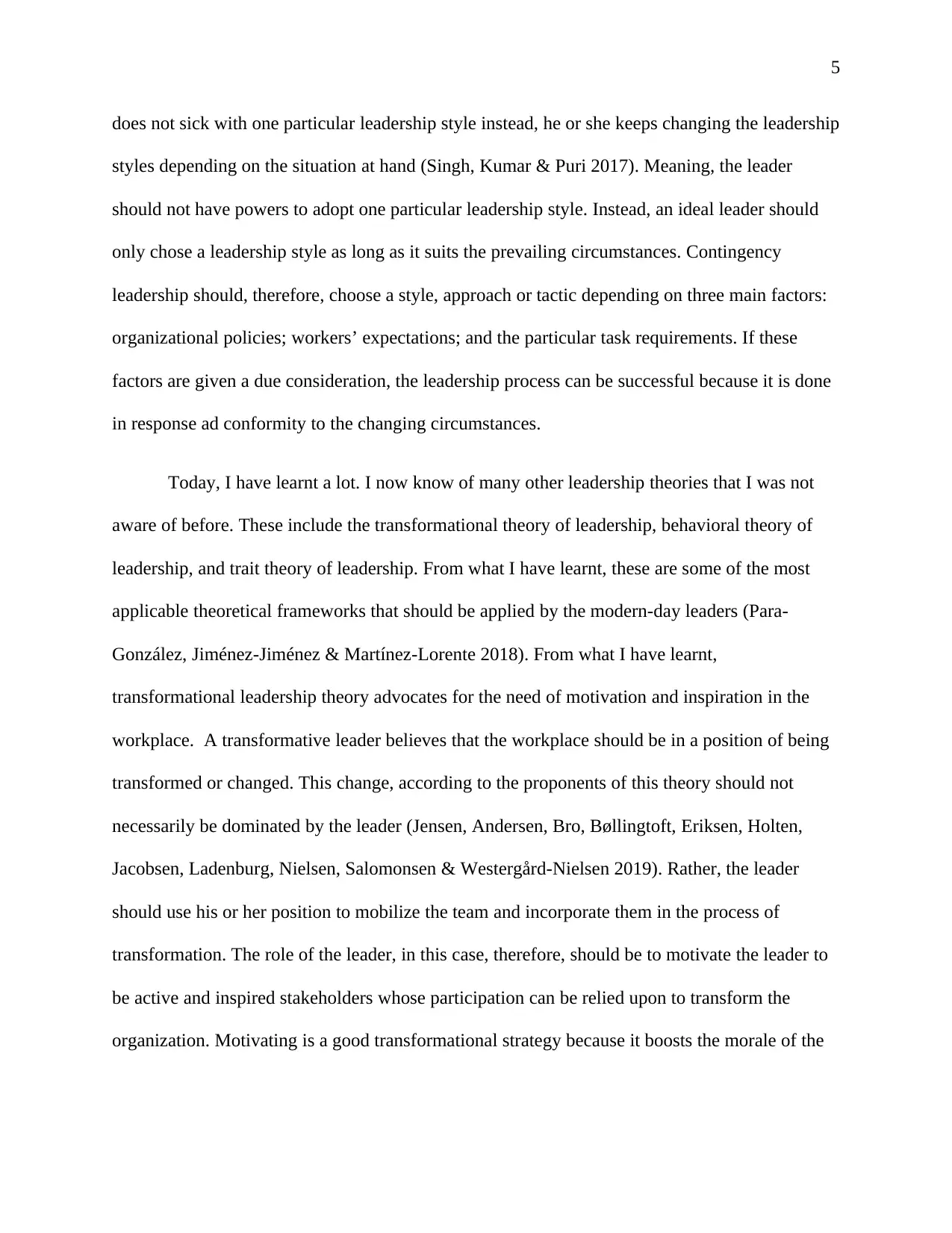
5
does not sick with one particular leadership style instead, he or she keeps changing the leadership
styles depending on the situation at hand (Singh, Kumar & Puri 2017). Meaning, the leader
should not have powers to adopt one particular leadership style. Instead, an ideal leader should
only chose a leadership style as long as it suits the prevailing circumstances. Contingency
leadership should, therefore, choose a style, approach or tactic depending on three main factors:
organizational policies; workers’ expectations; and the particular task requirements. If these
factors are given a due consideration, the leadership process can be successful because it is done
in response ad conformity to the changing circumstances.
Today, I have learnt a lot. I now know of many other leadership theories that I was not
aware of before. These include the transformational theory of leadership, behavioral theory of
leadership, and trait theory of leadership. From what I have learnt, these are some of the most
applicable theoretical frameworks that should be applied by the modern-day leaders (Para-
González, Jiménez-Jiménez & Martínez-Lorente 2018). From what I have learnt,
transformational leadership theory advocates for the need of motivation and inspiration in the
workplace. A transformative leader believes that the workplace should be in a position of being
transformed or changed. This change, according to the proponents of this theory should not
necessarily be dominated by the leader (Jensen, Andersen, Bro, Bøllingtoft, Eriksen, Holten,
Jacobsen, Ladenburg, Nielsen, Salomonsen & Westergård-Nielsen 2019). Rather, the leader
should use his or her position to mobilize the team and incorporate them in the process of
transformation. The role of the leader, in this case, therefore, should be to motivate the leader to
be active and inspired stakeholders whose participation can be relied upon to transform the
organization. Motivating is a good transformational strategy because it boosts the morale of the
does not sick with one particular leadership style instead, he or she keeps changing the leadership
styles depending on the situation at hand (Singh, Kumar & Puri 2017). Meaning, the leader
should not have powers to adopt one particular leadership style. Instead, an ideal leader should
only chose a leadership style as long as it suits the prevailing circumstances. Contingency
leadership should, therefore, choose a style, approach or tactic depending on three main factors:
organizational policies; workers’ expectations; and the particular task requirements. If these
factors are given a due consideration, the leadership process can be successful because it is done
in response ad conformity to the changing circumstances.
Today, I have learnt a lot. I now know of many other leadership theories that I was not
aware of before. These include the transformational theory of leadership, behavioral theory of
leadership, and trait theory of leadership. From what I have learnt, these are some of the most
applicable theoretical frameworks that should be applied by the modern-day leaders (Para-
González, Jiménez-Jiménez & Martínez-Lorente 2018). From what I have learnt,
transformational leadership theory advocates for the need of motivation and inspiration in the
workplace. A transformative leader believes that the workplace should be in a position of being
transformed or changed. This change, according to the proponents of this theory should not
necessarily be dominated by the leader (Jensen, Andersen, Bro, Bøllingtoft, Eriksen, Holten,
Jacobsen, Ladenburg, Nielsen, Salomonsen & Westergård-Nielsen 2019). Rather, the leader
should use his or her position to mobilize the team and incorporate them in the process of
transformation. The role of the leader, in this case, therefore, should be to motivate the leader to
be active and inspired stakeholders whose participation can be relied upon to transform the
organization. Motivating is a good transformational strategy because it boosts the morale of the
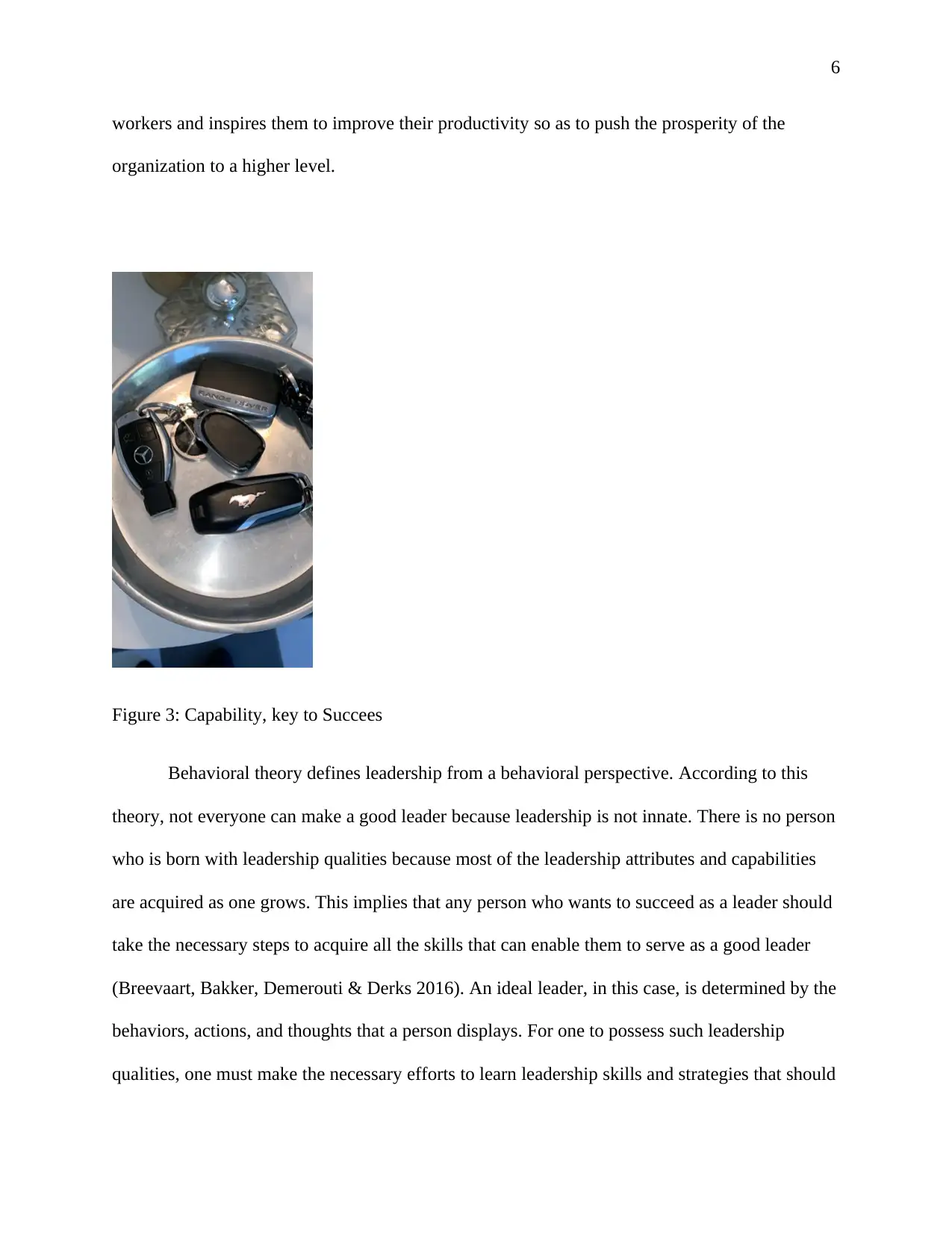
6
workers and inspires them to improve their productivity so as to push the prosperity of the
organization to a higher level.
Figure 3: Capability, key to Succees
Behavioral theory defines leadership from a behavioral perspective. According to this
theory, not everyone can make a good leader because leadership is not innate. There is no person
who is born with leadership qualities because most of the leadership attributes and capabilities
are acquired as one grows. This implies that any person who wants to succeed as a leader should
take the necessary steps to acquire all the skills that can enable them to serve as a good leader
(Breevaart, Bakker, Demerouti & Derks 2016). An ideal leader, in this case, is determined by the
behaviors, actions, and thoughts that a person displays. For one to possess such leadership
qualities, one must make the necessary efforts to learn leadership skills and strategies that should
workers and inspires them to improve their productivity so as to push the prosperity of the
organization to a higher level.
Figure 3: Capability, key to Succees
Behavioral theory defines leadership from a behavioral perspective. According to this
theory, not everyone can make a good leader because leadership is not innate. There is no person
who is born with leadership qualities because most of the leadership attributes and capabilities
are acquired as one grows. This implies that any person who wants to succeed as a leader should
take the necessary steps to acquire all the skills that can enable them to serve as a good leader
(Breevaart, Bakker, Demerouti & Derks 2016). An ideal leader, in this case, is determined by the
behaviors, actions, and thoughts that a person displays. For one to possess such leadership
qualities, one must make the necessary efforts to learn leadership skills and strategies that should
⊘ This is a preview!⊘
Do you want full access?
Subscribe today to unlock all pages.

Trusted by 1+ million students worldwide
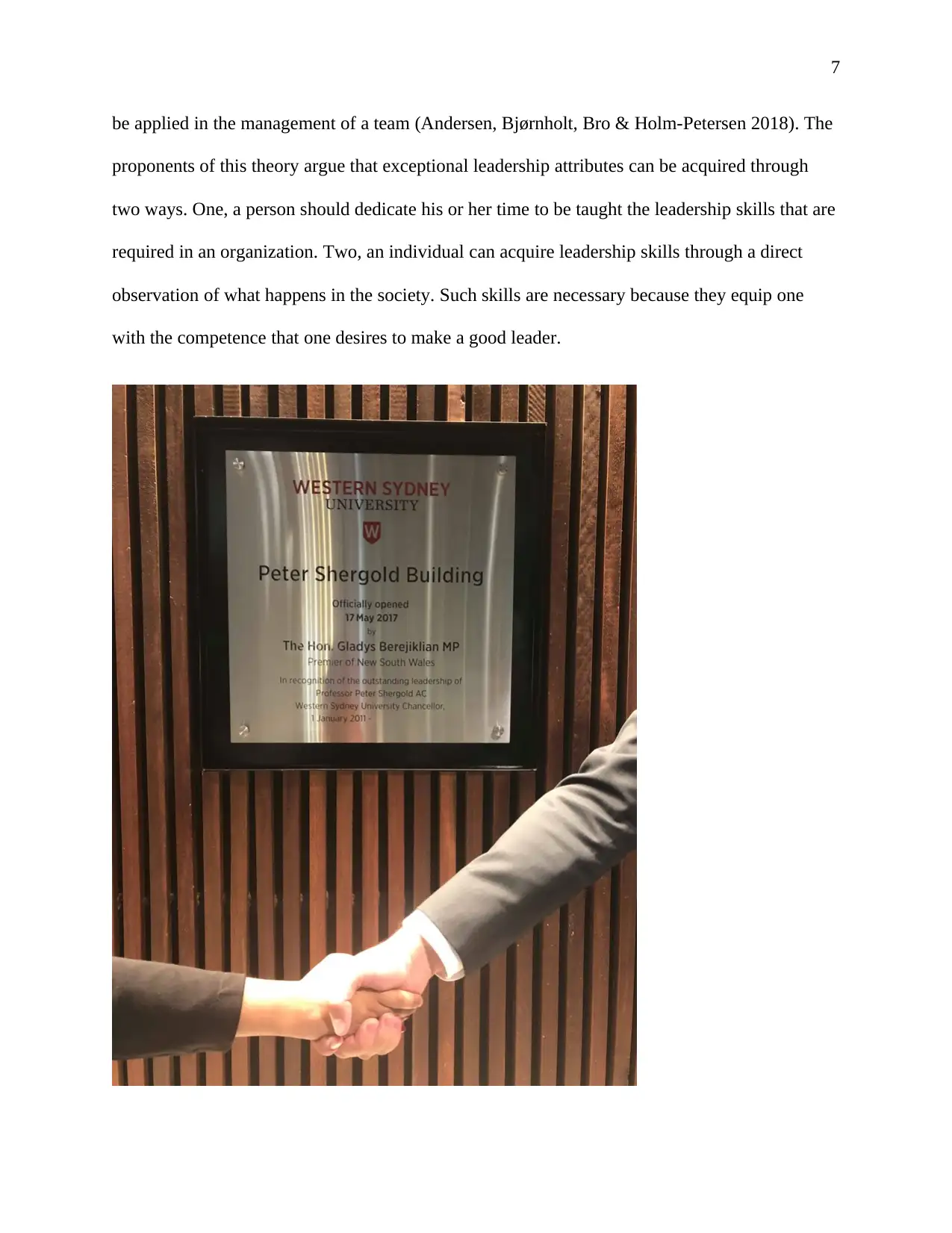
7
be applied in the management of a team (Andersen, Bjørnholt, Bro & Holm-Petersen 2018). The
proponents of this theory argue that exceptional leadership attributes can be acquired through
two ways. One, a person should dedicate his or her time to be taught the leadership skills that are
required in an organization. Two, an individual can acquire leadership skills through a direct
observation of what happens in the society. Such skills are necessary because they equip one
with the competence that one desires to make a good leader.
be applied in the management of a team (Andersen, Bjørnholt, Bro & Holm-Petersen 2018). The
proponents of this theory argue that exceptional leadership attributes can be acquired through
two ways. One, a person should dedicate his or her time to be taught the leadership skills that are
required in an organization. Two, an individual can acquire leadership skills through a direct
observation of what happens in the society. Such skills are necessary because they equip one
with the competence that one desires to make a good leader.
Paraphrase This Document
Need a fresh take? Get an instant paraphrase of this document with our AI Paraphraser
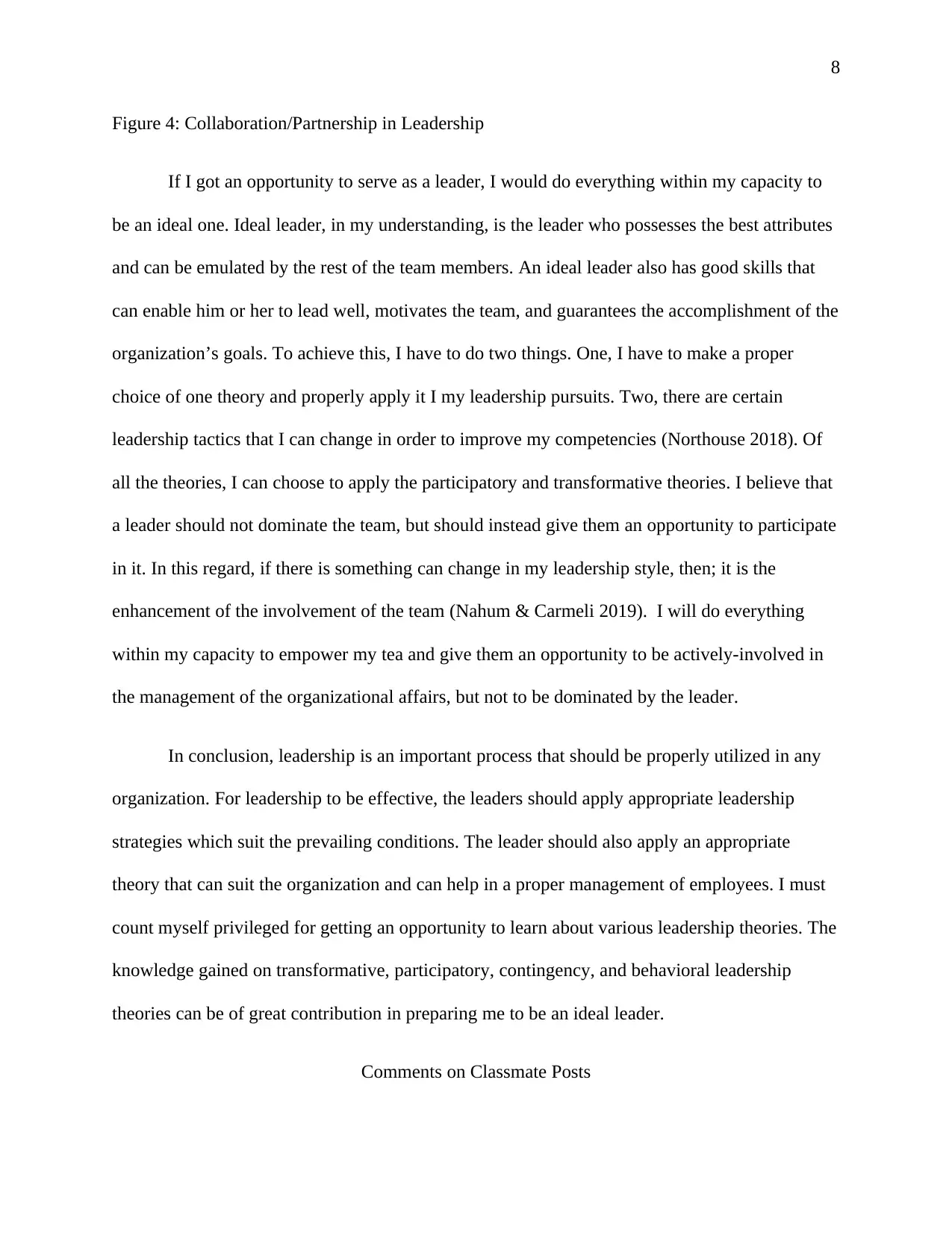
8
Figure 4: Collaboration/Partnership in Leadership
If I got an opportunity to serve as a leader, I would do everything within my capacity to
be an ideal one. Ideal leader, in my understanding, is the leader who possesses the best attributes
and can be emulated by the rest of the team members. An ideal leader also has good skills that
can enable him or her to lead well, motivates the team, and guarantees the accomplishment of the
organization’s goals. To achieve this, I have to do two things. One, I have to make a proper
choice of one theory and properly apply it I my leadership pursuits. Two, there are certain
leadership tactics that I can change in order to improve my competencies (Northouse 2018). Of
all the theories, I can choose to apply the participatory and transformative theories. I believe that
a leader should not dominate the team, but should instead give them an opportunity to participate
in it. In this regard, if there is something can change in my leadership style, then; it is the
enhancement of the involvement of the team (Nahum & Carmeli 2019). I will do everything
within my capacity to empower my tea and give them an opportunity to be actively-involved in
the management of the organizational affairs, but not to be dominated by the leader.
In conclusion, leadership is an important process that should be properly utilized in any
organization. For leadership to be effective, the leaders should apply appropriate leadership
strategies which suit the prevailing conditions. The leader should also apply an appropriate
theory that can suit the organization and can help in a proper management of employees. I must
count myself privileged for getting an opportunity to learn about various leadership theories. The
knowledge gained on transformative, participatory, contingency, and behavioral leadership
theories can be of great contribution in preparing me to be an ideal leader.
Comments on Classmate Posts
Figure 4: Collaboration/Partnership in Leadership
If I got an opportunity to serve as a leader, I would do everything within my capacity to
be an ideal one. Ideal leader, in my understanding, is the leader who possesses the best attributes
and can be emulated by the rest of the team members. An ideal leader also has good skills that
can enable him or her to lead well, motivates the team, and guarantees the accomplishment of the
organization’s goals. To achieve this, I have to do two things. One, I have to make a proper
choice of one theory and properly apply it I my leadership pursuits. Two, there are certain
leadership tactics that I can change in order to improve my competencies (Northouse 2018). Of
all the theories, I can choose to apply the participatory and transformative theories. I believe that
a leader should not dominate the team, but should instead give them an opportunity to participate
in it. In this regard, if there is something can change in my leadership style, then; it is the
enhancement of the involvement of the team (Nahum & Carmeli 2019). I will do everything
within my capacity to empower my tea and give them an opportunity to be actively-involved in
the management of the organizational affairs, but not to be dominated by the leader.
In conclusion, leadership is an important process that should be properly utilized in any
organization. For leadership to be effective, the leaders should apply appropriate leadership
strategies which suit the prevailing conditions. The leader should also apply an appropriate
theory that can suit the organization and can help in a proper management of employees. I must
count myself privileged for getting an opportunity to learn about various leadership theories. The
knowledge gained on transformative, participatory, contingency, and behavioral leadership
theories can be of great contribution in preparing me to be an ideal leader.
Comments on Classmate Posts
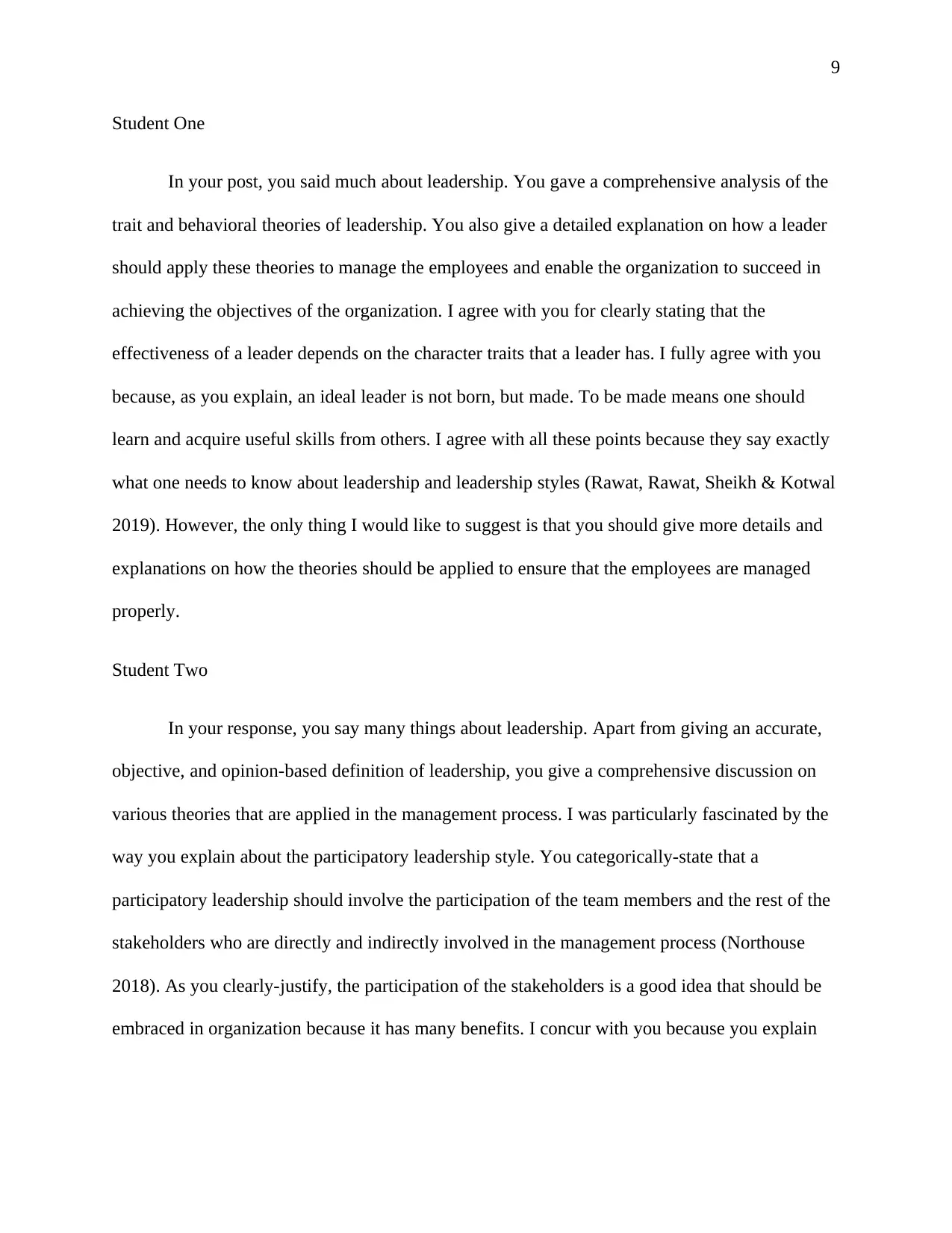
9
Student One
In your post, you said much about leadership. You gave a comprehensive analysis of the
trait and behavioral theories of leadership. You also give a detailed explanation on how a leader
should apply these theories to manage the employees and enable the organization to succeed in
achieving the objectives of the organization. I agree with you for clearly stating that the
effectiveness of a leader depends on the character traits that a leader has. I fully agree with you
because, as you explain, an ideal leader is not born, but made. To be made means one should
learn and acquire useful skills from others. I agree with all these points because they say exactly
what one needs to know about leadership and leadership styles (Rawat, Rawat, Sheikh & Kotwal
2019). However, the only thing I would like to suggest is that you should give more details and
explanations on how the theories should be applied to ensure that the employees are managed
properly.
Student Two
In your response, you say many things about leadership. Apart from giving an accurate,
objective, and opinion-based definition of leadership, you give a comprehensive discussion on
various theories that are applied in the management process. I was particularly fascinated by the
way you explain about the participatory leadership style. You categorically-state that a
participatory leadership should involve the participation of the team members and the rest of the
stakeholders who are directly and indirectly involved in the management process (Northouse
2018). As you clearly-justify, the participation of the stakeholders is a good idea that should be
embraced in organization because it has many benefits. I concur with you because you explain
Student One
In your post, you said much about leadership. You gave a comprehensive analysis of the
trait and behavioral theories of leadership. You also give a detailed explanation on how a leader
should apply these theories to manage the employees and enable the organization to succeed in
achieving the objectives of the organization. I agree with you for clearly stating that the
effectiveness of a leader depends on the character traits that a leader has. I fully agree with you
because, as you explain, an ideal leader is not born, but made. To be made means one should
learn and acquire useful skills from others. I agree with all these points because they say exactly
what one needs to know about leadership and leadership styles (Rawat, Rawat, Sheikh & Kotwal
2019). However, the only thing I would like to suggest is that you should give more details and
explanations on how the theories should be applied to ensure that the employees are managed
properly.
Student Two
In your response, you say many things about leadership. Apart from giving an accurate,
objective, and opinion-based definition of leadership, you give a comprehensive discussion on
various theories that are applied in the management process. I was particularly fascinated by the
way you explain about the participatory leadership style. You categorically-state that a
participatory leadership should involve the participation of the team members and the rest of the
stakeholders who are directly and indirectly involved in the management process (Northouse
2018). As you clearly-justify, the participation of the stakeholders is a good idea that should be
embraced in organization because it has many benefits. I concur with you because you explain
⊘ This is a preview!⊘
Do you want full access?
Subscribe today to unlock all pages.

Trusted by 1+ million students worldwide
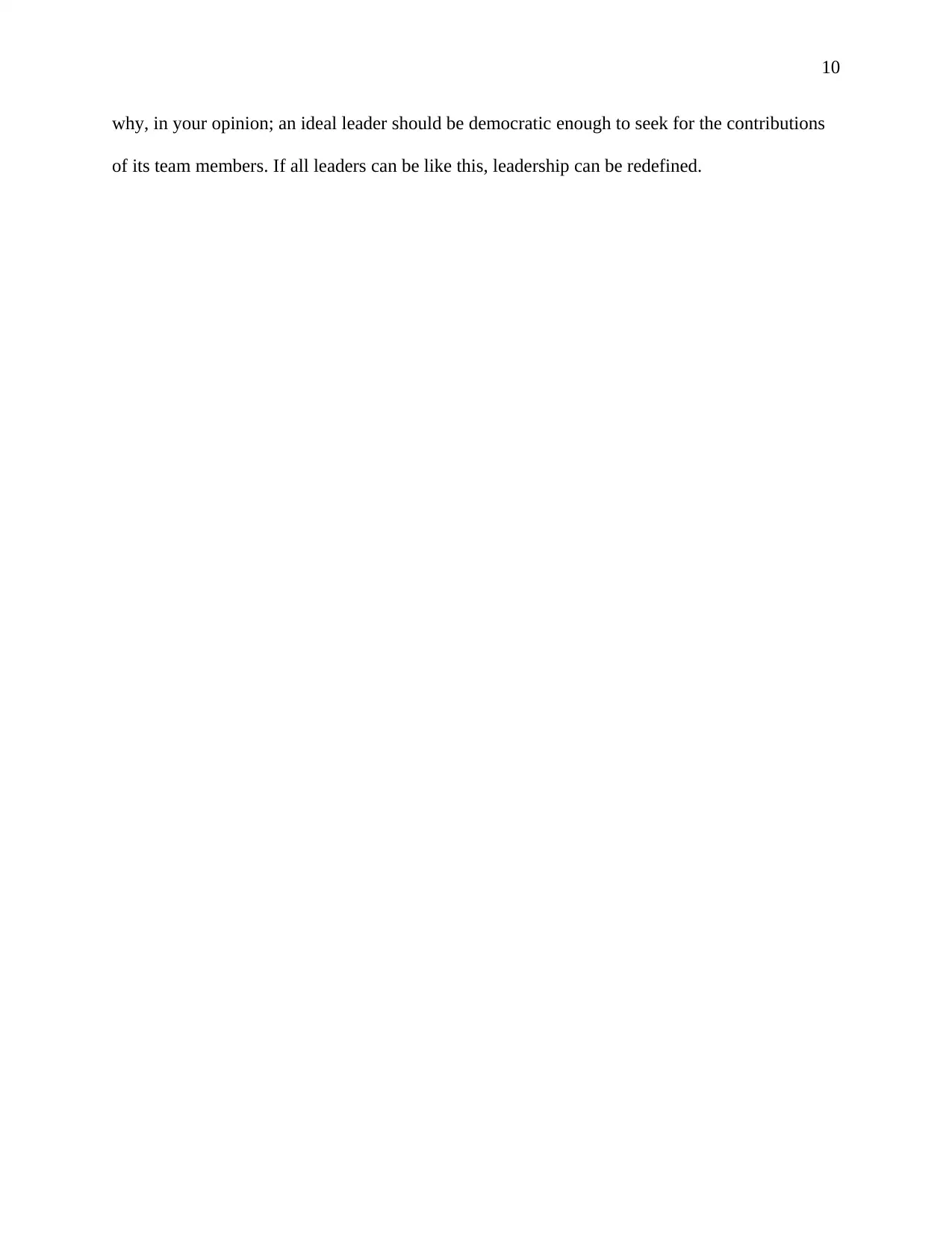
10
why, in your opinion; an ideal leader should be democratic enough to seek for the contributions
of its team members. If all leaders can be like this, leadership can be redefined.
why, in your opinion; an ideal leader should be democratic enough to seek for the contributions
of its team members. If all leaders can be like this, leadership can be redefined.
Paraphrase This Document
Need a fresh take? Get an instant paraphrase of this document with our AI Paraphraser
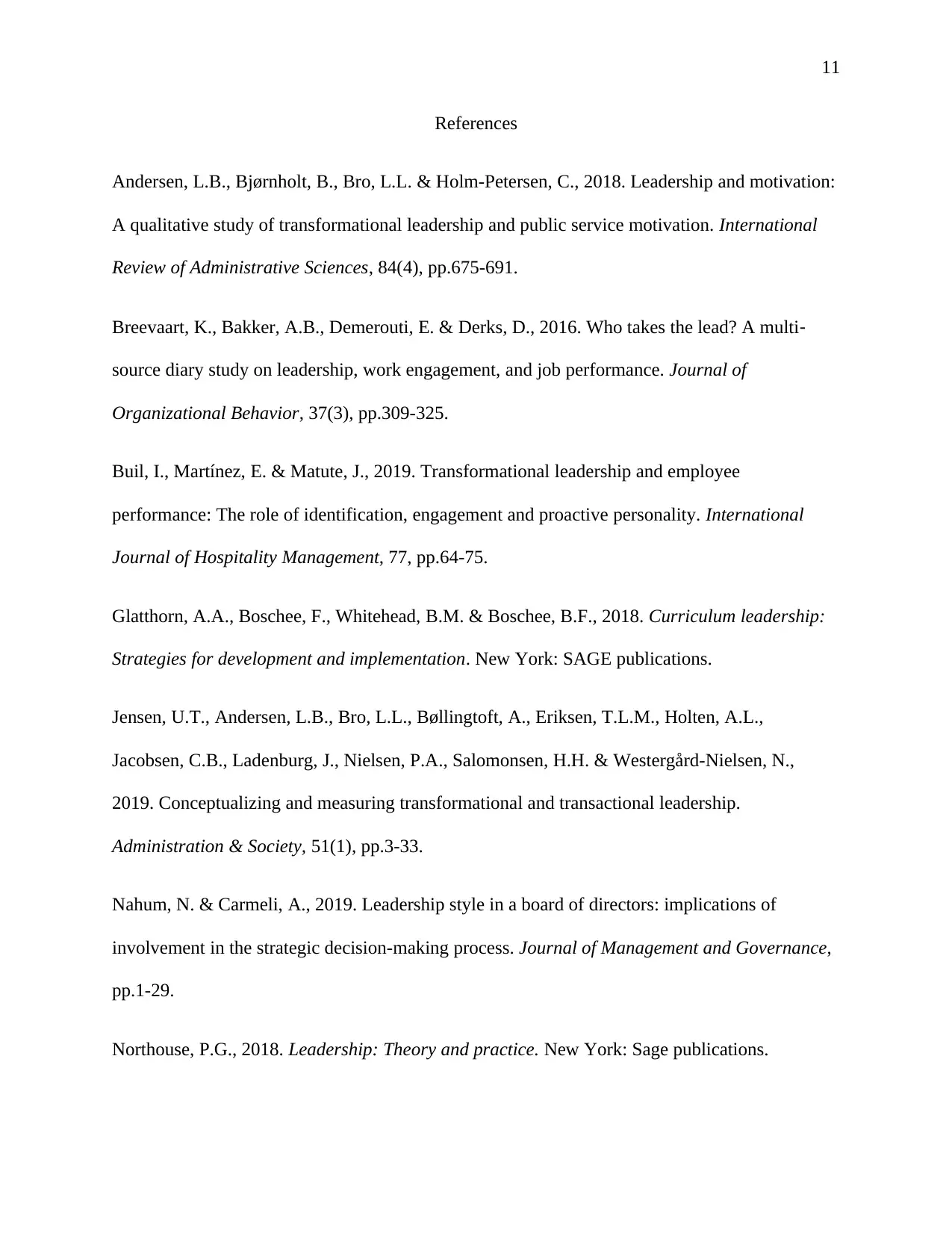
11
References
Andersen, L.B., Bjørnholt, B., Bro, L.L. & Holm-Petersen, C., 2018. Leadership and motivation:
A qualitative study of transformational leadership and public service motivation. International
Review of Administrative Sciences, 84(4), pp.675-691.
Breevaart, K., Bakker, A.B., Demerouti, E. & Derks, D., 2016. Who takes the lead? A multi‐
source diary study on leadership, work engagement, and job performance. Journal of
Organizational Behavior, 37(3), pp.309-325.
Buil, I., Martínez, E. & Matute, J., 2019. Transformational leadership and employee
performance: The role of identification, engagement and proactive personality. International
Journal of Hospitality Management, 77, pp.64-75.
Glatthorn, A.A., Boschee, F., Whitehead, B.M. & Boschee, B.F., 2018. Curriculum leadership:
Strategies for development and implementation. New York: SAGE publications.
Jensen, U.T., Andersen, L.B., Bro, L.L., Bøllingtoft, A., Eriksen, T.L.M., Holten, A.L.,
Jacobsen, C.B., Ladenburg, J., Nielsen, P.A., Salomonsen, H.H. & Westergård-Nielsen, N.,
2019. Conceptualizing and measuring transformational and transactional leadership.
Administration & Society, 51(1), pp.3-33.
Nahum, N. & Carmeli, A., 2019. Leadership style in a board of directors: implications of
involvement in the strategic decision-making process. Journal of Management and Governance,
pp.1-29.
Northouse, P.G., 2018. Leadership: Theory and practice. New York: Sage publications.
References
Andersen, L.B., Bjørnholt, B., Bro, L.L. & Holm-Petersen, C., 2018. Leadership and motivation:
A qualitative study of transformational leadership and public service motivation. International
Review of Administrative Sciences, 84(4), pp.675-691.
Breevaart, K., Bakker, A.B., Demerouti, E. & Derks, D., 2016. Who takes the lead? A multi‐
source diary study on leadership, work engagement, and job performance. Journal of
Organizational Behavior, 37(3), pp.309-325.
Buil, I., Martínez, E. & Matute, J., 2019. Transformational leadership and employee
performance: The role of identification, engagement and proactive personality. International
Journal of Hospitality Management, 77, pp.64-75.
Glatthorn, A.A., Boschee, F., Whitehead, B.M. & Boschee, B.F., 2018. Curriculum leadership:
Strategies for development and implementation. New York: SAGE publications.
Jensen, U.T., Andersen, L.B., Bro, L.L., Bøllingtoft, A., Eriksen, T.L.M., Holten, A.L.,
Jacobsen, C.B., Ladenburg, J., Nielsen, P.A., Salomonsen, H.H. & Westergård-Nielsen, N.,
2019. Conceptualizing and measuring transformational and transactional leadership.
Administration & Society, 51(1), pp.3-33.
Nahum, N. & Carmeli, A., 2019. Leadership style in a board of directors: implications of
involvement in the strategic decision-making process. Journal of Management and Governance,
pp.1-29.
Northouse, P.G., 2018. Leadership: Theory and practice. New York: Sage publications.
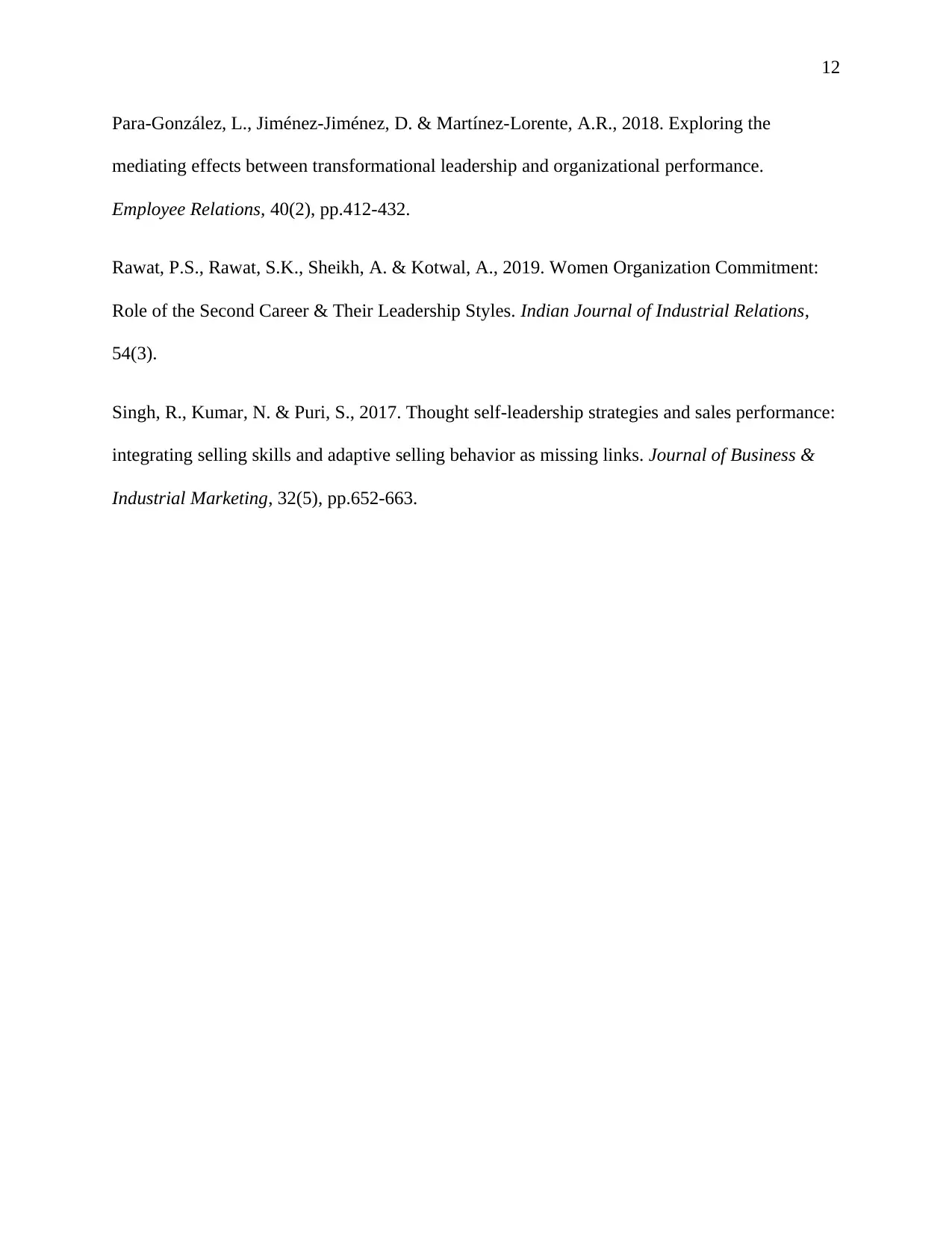
12
Para-González, L., Jiménez-Jiménez, D. & Martínez-Lorente, A.R., 2018. Exploring the
mediating effects between transformational leadership and organizational performance.
Employee Relations, 40(2), pp.412-432.
Rawat, P.S., Rawat, S.K., Sheikh, A. & Kotwal, A., 2019. Women Organization Commitment:
Role of the Second Career & Their Leadership Styles. Indian Journal of Industrial Relations,
54(3).
Singh, R., Kumar, N. & Puri, S., 2017. Thought self-leadership strategies and sales performance:
integrating selling skills and adaptive selling behavior as missing links. Journal of Business &
Industrial Marketing, 32(5), pp.652-663.
Para-González, L., Jiménez-Jiménez, D. & Martínez-Lorente, A.R., 2018. Exploring the
mediating effects between transformational leadership and organizational performance.
Employee Relations, 40(2), pp.412-432.
Rawat, P.S., Rawat, S.K., Sheikh, A. & Kotwal, A., 2019. Women Organization Commitment:
Role of the Second Career & Their Leadership Styles. Indian Journal of Industrial Relations,
54(3).
Singh, R., Kumar, N. & Puri, S., 2017. Thought self-leadership strategies and sales performance:
integrating selling skills and adaptive selling behavior as missing links. Journal of Business &
Industrial Marketing, 32(5), pp.652-663.
⊘ This is a preview!⊘
Do you want full access?
Subscribe today to unlock all pages.

Trusted by 1+ million students worldwide
1 out of 19
Related Documents
Your All-in-One AI-Powered Toolkit for Academic Success.
+13062052269
info@desklib.com
Available 24*7 on WhatsApp / Email
![[object Object]](/_next/static/media/star-bottom.7253800d.svg)
Unlock your academic potential
Copyright © 2020–2025 A2Z Services. All Rights Reserved. Developed and managed by ZUCOL.




